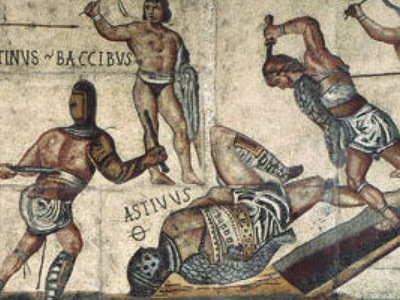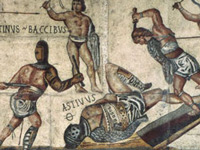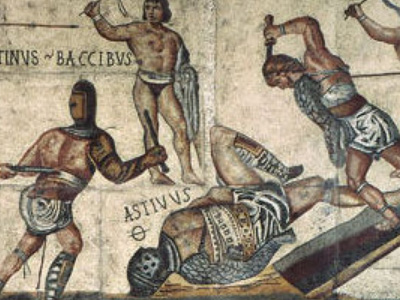Third Servile War (73-71 BC)

Defeat of the Consular Armies (72 BC)
In the spring of 72 BC, the escaped slaves left their winter encampments and began to move northwards towards Cisalpine Gaul.
The Senate, alarmed by the size of the revolt and the defeat of the praetorian armies of Glaber and Varinius, dispatched a pair of consular legions under the command of Lucius Gellius Publicola and Gnaeus Cornelius Lentulus Clodianus. Initially, the consular armies were successful. Gellius engaged a group of about 30,000 slaves, under the command of Crixus, near Mount Garganus and killed two-thirds of the rebels, including Crixus himself.
At this point, there is a divergence in the classical sources as to the course of events which cannot be reconciled until the entry of Marcus Licinius Crassus into the war. The two most comprehensive (extant) histories of the war by Appian and Plutarch detail very different events. However, neither account directly contradicts the other, but simply reports different events, ignoring some events in the other account, and reporting events that are unique to that account.
Appian's History
According to Appian, the battle between Gellius' legions and Crixus' men near Mount Garganus was the beginning of a long and complex series of military maneuvers that almost resulted in the Spartacan forces directly assaulting the city of Rome itself.
After his victory over Crixus, Gellius moved northwards, following the main group of slaves under Spartacus who were heading for Cisalpine Gaul. The army of Lentulus was deployed to bar Spartacus' path, and the consuls hoped to trap the rebel slaves between them. Spartacus' army met Lentulus' legion, defeated it, turned, and destroyed Gellius' army, forcing the Roman The Roman Republic was a form of government of Rome and the era of the classical Roman civilization when it was run through public representation of the Roman people. Beginning with the overthrow of the Roman Kingdom (traditionally dated to 509 BC) and ending in 27 BC with the establishment of the Roman Empire, Rome's control rapidly expanded during this period - from the city's immediate surroundings to hegemony over the entire Mediterranean world. legions to retreat in disarray.
The Roman Republic was a form of government of Rome and the era of the classical Roman civilization when it was run through public representation of the Roman people. Beginning with the overthrow of the Roman Kingdom (traditionally dated to 509 BC) and ending in 27 BC with the establishment of the Roman Empire, Rome's control rapidly expanded during this period - from the city's immediate surroundings to hegemony over the entire Mediterranean world. legions to retreat in disarray.
Appian claims that Spartacus executed some 300 captured Roman soldiers to avenge the death of Crixus, forcing them to fight each other to the death as gladiators. Following this victory, Spartacus pushed northwards with his followers (some 120,000) as fast as he could travel, "having burned all his useless material, killed all his prisoners, and butchered his pack-animals in order to expedite his movement".
The defeated consular armies fell back to Rome to regroup while Spartacus' followers moved northward. The consuls again engaged Spartacus somewhere in the Picenum region, and once again were defeated.
Appian claims that at this point Spartacus changed his intention of marching on Rome—implying this was Spartacus' goal following the confrontation in Picenum—as "he did not consider himself ready as yet for that kind of a fight, as his whole force was not suitably armed, for no city had joined him, but only slaves, deserters, and riff-raff", and decided to withdraw into southern Italy once again. They seized the town of Thurii and the surrounding countryside, arming themselves, raiding the surrounding territories, trading plunder with merchants for bronze and iron (with which to manufacture more arms), and clashing occasionally with Roman forces which were invariably defeated.
Plutarch's History
Plutarch's description of events differs significantly from Appian's.
According to Plutarch, after the battle between Gellius' legion and Crixus's men (whom Plutarch describes as "Germans") near Mount Garganus, Spartacus' men engaged the legion commanded by Lentulus, defeated them, seized their supplies and equipment, and pushed directly into northern Italy. After this defeat, both consuls were relieved of command of their armies by the Roman Senate and recalled to Rome. Plutarch does not mention Spartacus engaging Gellius' legion at all, nor of Spartacus facing the combined consular legions in Picenum.
Plutarch then goes on to detail a conflict not mentioned in Appian's history. According to Plutarch, Spartacus' army continued northwards to the region around Mutina (modern Modena). There, a Roman army of some 10,000 soldiers, led by the governor of Cisalpine Gaul, Gaius Cassius Longinus attempted to bar Spartacus' progress and was also defeated.
Plutarch makes no further mention of events until the initial confrontation between Marcus Licinius Crassus and Spartacus in the spring of 71 BC, omitting the march on Rome and the retreat to Thurii described by Appian. However, as Plutarch describes Crassus forcing Spartacus' followers to retreat southwards from Picenum, it could be inferred that the rebel slaves approached Picenum from the south in early 71 BC, implying that they withdrew from Mutina into southern or central Italy for the winter of 72–71 BC.
Why they might do so, when there was apparently no reason for them not to escape over the Alps—Spartacus' goal according to Plutarch—is not explained.
HISTORY

RESOURCES
This article uses material from the Wikipedia article "Third Servile War (73-71 BC)", which is released under the Creative Commons Attribution-Share-Alike License 3.0.
© Stories Preschool. All Rights Reserved.









